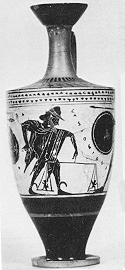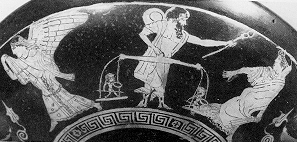| The legend of Psychostasia - the weighing of souls - first appears in Homer's "Iliad" (XXII, 220). It is also the subject of the lost epic "Aethiopis", and Aeschylus' lost tragedy "Psychostasia". |
The weighing of souls was Zeus' method of deciding which of two confronted heroes would die in combat. He would place a death spirit for each of the heroes in the pans of the scales. The heavier spirit who sinks the scales is doomed.
This scene is illustrated on vases |
 Click to see a larger image |
 |
On the vase above, (white ground black figure lekythos, by The Sappho Painter from c.500 BC) Hermes can be seen weighing souls. Occasionally, as in the Attic red figure cup on the right from 450 BC, the heroes' mothers are shown. Hermes is weighing Eidola (death spirits) of Memnon and Achilles while their mothers, Eos and Thetis, rush to the right and the left. |
| This, then, is the opposite of what is usually shown in Greek art. However, in Medieval and early Renaissance art, the heavier soul was believed to go to heaven in depictions of Psychostasia. Did the ancient sculptor of the Boston Throne intentionally or unintentionally misrepresent the myth, or have modern forgers been confused between subsequent representations of Psychostasia? Does the relief show Psychostasia at all? |
On the Boston Throne, a winged youth presides over the scale pans. In conventional representations of Psychostasia, it would be Zeus or Hermes. The young men on the scale pans on the Boston Throne are shown hanging with their hands above their heads. (Unfortunately, no close up images of this were available.) This is the conventional representation of prisoners in Greek art. Souls are represented as winged naked young men. Are the two figures not death spirits at all? |
| Perhaps the Boston Throne does not represent Psychostasia at all, but a transaction between the two females, presided over by the god of love, Eros, or the god of death, Thanatos. The problem of identifying the winged youth and the two females confuses this issue, and lead to various theories concerning the meaning of the myth. |